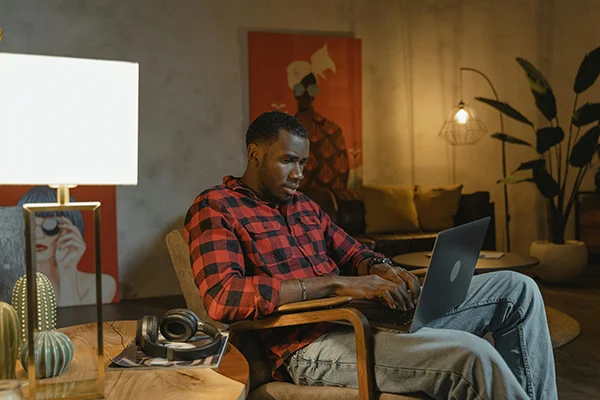
Working from home is no longer a temporary arrangement but an established part of modern life. Many people now face the challenge of creating a dedicated home office without the luxury of spare rooms. The truth is that you only need a thoughtfully arranged corner. A home office can exist in the tiniest apartment, a shared living space, or even a hallway alcove. With a bit of creativity, you can turn almost any spot into a personal workspace that supports focus and comfort.
Before diving into design tips, remember that the right setup will enhance productivity, improve well-being, reduce stress, and foster a sense of control over your day. That’s why students and professionals alike search for advice ranging from ergonomic furniture to digital assistance, sometimes even asking services to write my paper with high quality when deadlines pile up. Having a proper space to work means you can tackle projects efficiently without feeling overwhelmed.
Why a Home Office Matters
A home office gives structure to your day. Without it, working from the couch or bed blurs the line between personal and professional life, which makes it difficult to disconnect and rest. A designated space creates boundaries, signaling to your mind and body when it’s time to focus and when it’s time to relax.
Even if your living arrangement is temporary or small, investing effort in carving out a space makes a big difference. It doesn’t have to be expensive or elaborate. What matters is consistency. A single chair, desk, and good lighting can become the foundation for a daily routine.
Choosing the Right Spot
The first step in building a home office is finding the right corner. Look for underutilized areas in your home. For example:
- A wide hallway can hold a slim desk.
- An unused closet can become a “cloffice.”
- A bedroom corner can be transformed with a floating shelf as a desk.
- A window ledge can double as a writing nook.
The goal is to identify areas with minimal distractions. Even a spot near the kitchen can work if you use dividers or shelves to create visual separation.
Furniture That Fits
Traditional desks aren’t always an option, especially in small apartments. Fortunately, flexible alternatives exist: wall-mounted desks, fold-out tables, or adjustable laptop stands. Pair these with ergonomic chairs or even seat cushions and back supports if you’re using an existing chair.
Your setup doesn’t need to be expensive, but it should respect posture. Spending hours hunched over a laptop on a couch eventually takes a toll. Investing in one supportive chair or a monitor riser can prevent discomfort and long-term health issues.
Lighting for Productivity
Lighting has a direct effect on energy and mood. Natural light is ideal, so positioning your workspace near a window is the best option. If that isn’t possible, combine overhead lighting with task lamps. Warm light creates a cozy atmosphere for evening work, while cool white light helps you stay alert during the day.
For small corners, LED strip lights can make the space feel defined and intentional. A bright, well-lit nook signals “work zone,” even if it’s only a few feet wide.
Organizing Essentials
Clutter reduces focus. Since compact workspaces don’t allow for much storage, organization is essential. Wall shelves, pegboards, and vertical storage systems maximize limited space. Drawer organizers or storage boxes help keep supplies contained.
Digital organization matters just as much. Having clear folders on your computer, reliable study apps, and even a second monitor for multitasking can streamline your work. Many people underestimate how much stress simple organization can relieve.
Personalizing the Space
A home office should feel like yours. Adding personal touches such as plants, artwork, or framed photos boosts comfort and motivation. Plants in particular have been shown to improve mood and productivity.
However, avoid over-decorating. The goal is balance. You need enough personality to inspire, but not so much that it distracts. Choose one or two meaningful elements rather than filling the space with too many objects.
Managing Distractions
Working in small or shared spaces often means interruptions. Headphones, noise-canceling apps, or even a simple curtain divider can help create psychological boundaries. If children or roommates are present, setting clear communication about “focus hours” is essential.
Technology also plays a role in distraction management. Productivity apps, focus timers, and online platforms help keep work on track. Setting specific goals for each work session also strengthens discipline, even when the environment isn’t ideal.
Multi-Functional Corners
Your home office doesn’t have to be limited to work. In small homes, creating a flexible corner allows it to serve multiple purposes. A desk setup might double as a vanity, study table, or crafting station. The trick is to keep it organized so that switching between functions is seamless.
Furniture designed for small spaces, like foldable chairs or movable carts, makes transitioning between activities much easier. This flexibility ensures that your home doesn’t feel dominated by work equipment.
The Role of Routine
A workspace only becomes effective when paired with consistent habits. Start the day by “commuting” to your corner, even if it’s only five steps away. Keep water nearby to stay hydrated, and schedule breaks to stretch.
Routines signal to your mind that work has started and ended. Without them, the boundary between professional and personal life blurs again. That’s why many remote workers emphasize rituals like making coffee before sitting down or tidying the desk at the end of the day.
Technology as a Support System
Digital tools enhance small home offices. From cloud storage to project management platforms, technology ensures you can work effectively without needing piles of paper.
For students, academic tools are especially important. Whether it’s citation generators, grammar checkers, or platforms that provide editing support, technology reduces stress and saves time. This blend of digital organization and physical setup allows even the smallest workspace to function like a professional office.
Final Thoughts
To create a home office you just need to follow through with your intentions. Any corner can transform into a workspace with the right furniture, lighting, and organization. Personal touches bring comfort, while routines and technology ensure productivity.
The reality is that remote work will remain part of modern life. Adapting your space to meet those demands empowers you to stay organized, focused, and healthy. Whether you’re handling professional projects, creative tasks, or academic deadlines, a dedicated corner gives you the structure you need.
Your home already has the space. All you need to do is define it. Once you do, the benefits ripple into every part of your life: better focus, healthier routines, and a stronger sense of balance between work and rest.

